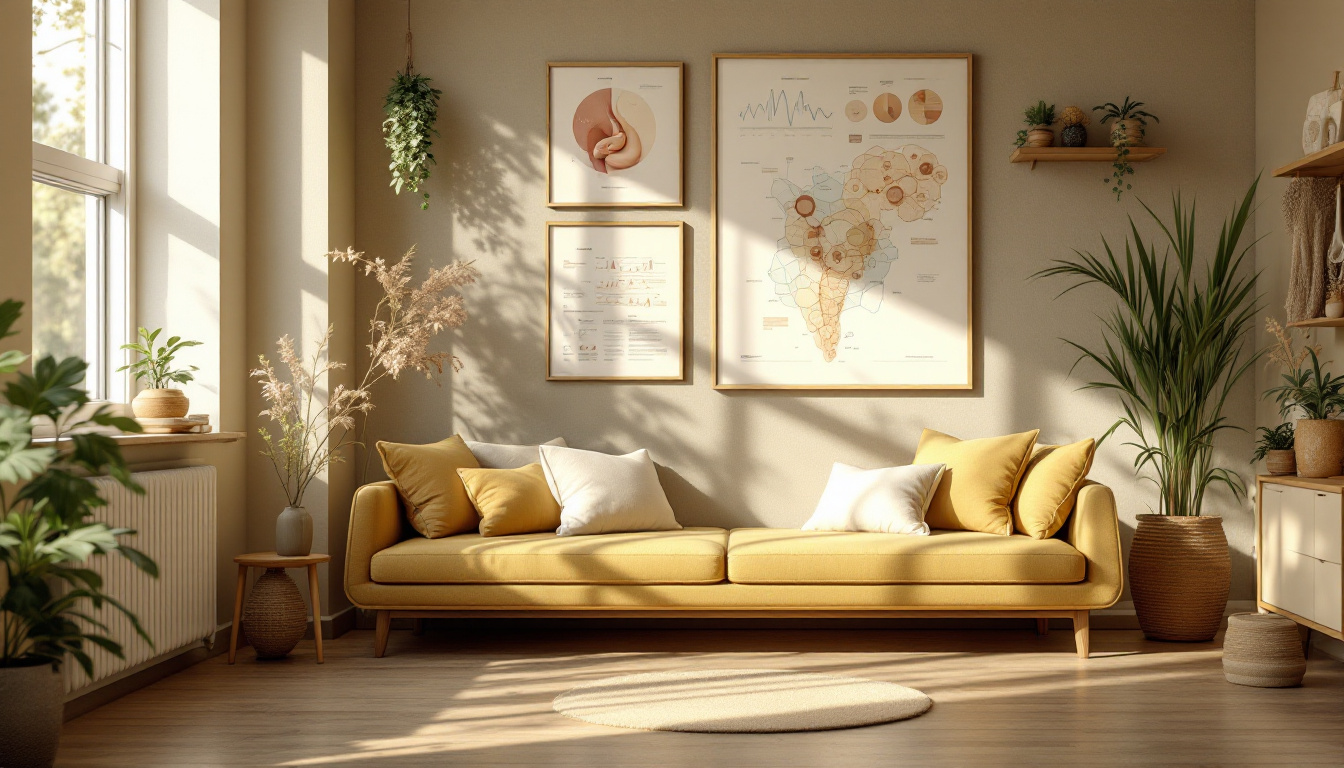The Role of Serenity in Enhancing Your Productivity
Harnessing Calm: Transforming Workspaces to Boost Productivity

Understanding the Power of Serenity in the Workplace
In today’s fast-paced work environment, the pursuit of serenity is more than just a matter of comfort—it's a strategic approach to enhance productivity, foster well-being, and improve organizational performance. By cultivating calmness through mindful practices, organized spaces, and natural elements, organizations and individuals can unlock their full potential, ensuring that work is both effective and fulfilling.
The Psychological and Performance Benefits of Serenity

How does serenity impact stress levels and work effectiveness?
Creating a serene work environment plays a crucial role in reducing stress and boosting productivity. Such spaces provide employees with a calming atmosphere that encourages relaxation, mindfulness, and mental clarity.
Implementing dedicated areas—like serenity rooms—equipped with calming decor, natural lighting, and soothing sounds allows staff to take restorative breaks. This helps decrease feelings of anxiety and emotional exhaustion, which are common sources of burnout.
During the COVID-19 pandemic, many healthcare facilities integrated tools such as massage chairs, aromatherapy, and peaceful decor into their serenity spaces. These enhancements have been linked to reductions in secondary traumatic stress and improved staff resilience.
Strong leadership support and staff involvement are essential to promote the regular use of these spaces. When employees have easy access to tranquility zones, they experience increased focus, renewed energy, and higher job satisfaction.
Moreover, mindfulness-based stress reduction (MBSR) programs implemented within workplaces foster greater self-awareness and compassion. While these practices effectively mitigate stress, their influence on overall resilience and burnout may vary among individuals.
In summary, fostering serenity helps healthcare workers and professionals manage their stress more effectively. This not only enhances individual well-being but also leads to improved work performance and better quality of care.
Creating Serene Workspaces for Better Productivity

What benefits and characteristics of a peaceful workspace?
Creating a serene workspace provides significant advantages for both employee productivity and well-being. Such environments help in reducing stress and mental fatigue by incorporating natural elements like plants and water features, along with calming color palettes such as blues, greens, and earth tones. Ergonomic furniture and well-planned lighting improve comfort, allowing for sustained focus. Design features that minimize noise and improve air quality further foster mental clarity. These peaceful settings promote positive moods, increase employee engagement, and boost overall job satisfaction. When the environment feels calm and structured, it encourages better health, higher performance, and a more harmonious work atmosphere, reducing burnout and turnover.
What role do natural elements and organization play in promoting serenity in the workplace?
Natural elements and good organization are central to cultivating serenity at work. Incorporating biophilic design—such as natural light, greenery, and water features—can elevate mood, support mindfulness, and reinforce the connection between individuals and their environment. These natural touches are beneficial for emotional balance and overall health.
Well-organized spaces that combine natural elements with thoughtfully arranged decor create a sense of order and harmony, reducing distractions and fostering focus. Clear pathways, minimal clutter, and efficient layouts help employees feel more in control and less overwhelmed. Access to outdoor or natural settings encourages breaks, reflection, and physical activity, which further enhances emotional resilience and energy levels.
Tables summarizing this information:
| Design Element | Purpose and Benefit | Additional Details |
|---|---|---|
| Natural Light | Improves mood, reduces stress | Best when abundant and well-distributed |
| Indoor Plants | Boosts mood, lowers cortisol levels | Easy to maintain and strategically placed |
| Water Features | Promotes relaxation | Can include small fountains or aquariums |
| Organized Space | Enhances focus, reduces distraction | Clean, decluttered, with clear zones |
| Natural Colors | Calms the mind | Soft, neutral tones like greens and blues |
| Cleanliness and Order | Prepares a calm mental state | Regular tidiness supports peace of mind |
In conclusion, integrating natural elements with organized, clutter-free spaces nurtures tranquility, strengthens focus, and supports employee health. A balanced combination of these principles fosters an atmosphere where productivity and serenity thrive.
Incorporating Mindfulness and Meditation to Foster Calm and Clarity

How can incorporating serenity and mindfulness into work routines improve mental clarity and performance?
Integrating serenity practices and mindfulness in daily work routines can significantly elevate mental clarity. These practices encourage employees to remain present, which reduces wandering thoughts and distractions that often impair focus. By promoting a state of relaxation, mindfulness techniques lower stress, activate the body's relaxation response, and prevent burnout—a common obstacle to sustained performance.
Mindfulness enhances emotional regulation by helping individuals respond thoughtfully rather than react impulsively, leading to better communication and stronger teamwork. This clarity fosters effective decision-making and problem-solving, as mental clutter is cleared, allowing creative ideas to flourish.
Additionally, a mindful approach encourages curiosity and openness, which can drive innovation and improve adaptability in a fast-changing work environment. Overall, embedding serenity and mindfulness into routine activities cultivates a resilient, attentive, and highly productive workforce, capable of navigating complex tasks with calm and focus.
Physical and Organizational Strategies to Cultivate Calmness

What strategies can be used to foster calmness and mental clarity at work?
Creating a tranquil work environment is essential for promoting mental clarity and reducing stress. Simple organizational practices like decluttering your workspace can significantly impact psychological well-being. An organized office not only reduces distractions but also fosters a feeling of control and calm, making it easier to focus on tasks.
Incorporating natural elements, such as indoor plants, water features, or even views of outdoor scenery, can greatly enhance serenity. Studies have shown that natural scenery has psychological benefits, including improved attention and reduced mental fatigue. These elements help lower cortisol levels, contributing to a more relaxed state of mind.
Physical comfort also plays a crucial role. Ergonomic furniture, such as adjustable chairs and desks, supports good posture and reduces physical discomfort. Comfortable and supportive seating minimizes distractions caused by discomfort, allowing employees to maintain focus longer.
Effective communication and clarity of expectations are vital for reducing workplace confusion and stress. Using performance indicators like KPIs or OKRs helps set clear goals, aligning team efforts and fostering a sense of purpose. Regular, transparent communication ensures everyone understands their roles and responsibilities, which enhances psychological safety.
In addition to physical and organizational adjustments, practices like mindfulness, deep breathing, and short meditation exercises can help employees stay present. Encouraging frequent breaks and physical activity further supports mental resilience.
Supporting work-life balance by setting boundaries and promoting regular downtime is essential. Cultivating a culture of kindness, recognition, and open dialogue encourages employees to express concerns and share feedback without fear, fostering a sense of security and community.
In summary, implementing bunch of physical and organizational strategies—like maintaining an organized and natural workspace, ensuring ergonomic comfort, and promoting clear, supportive communication—builds a solid foundation for mental clarity and calmness at work.
The Impact of Serenity on Stress Management and Work Resilience
How does serenity impact stress levels and work effectiveness?
Creating a serene work environment plays a significant role in how individuals experience stress and perform their duties. Spaces designed with calming elements, natural lighting, and organized layouts help reduce feelings of anxiety and mental fatigue. For healthcare staff, having dedicated serenity rooms allows moments of quiet reflection, meditation, or relaxation, which can substantially ease emotional exhaustion and decrease burnout.
The implementation of calming tools such as massage chairs, aromatherapy, and soothing decor complements these spaces by enhancing relaxation. During demanding times like the COVID-19 pandemic, many hospitals introduced these environments to support staff well-being. Evidence shows that such interventions lead to lower stress levels, reduced secondary traumatic stress, and a more resilient workforce.
Leadership support and staff involvement are crucial in encouraging regular use of serenity spaces. When accessible and promoted within organizational culture, these areas help staff recharge, regain focus, and increase job satisfaction. Mindfulness-based approaches, including mindfulness meditation and self-compassion exercises, further promote mental clarity and emotional stability. Though their direct effect on resilience may vary, their overall contribution to stress reduction is well acknowledged.
In summary, fostering serenity in the workplace not only alleviates stress but also enhances work effectiveness through improved focus, emotional resilience, and a supportive environment. Healthcare professionals who incorporate these calming practices and spaces find it easier to manage daily pressures, providing better patient care and maintaining personal well-being.
The Link Between Serenity, Stress Reduction, and Work Effectiveness

What is the connection between serenity, stress reduction, and work effectiveness?
Serenity plays a vital role in reducing work-related stress and improving overall effectiveness. When workplaces incorporate calming elements such as natural lighting, greenery, and organized spaces, employees experience lower cortisol levels—hormones linked to stress—leading to enhanced mental clarity and calmness. Practices like mindfulness and meditation further help employees stay present, manage emotional responses, and foster resilience.
Reducing stress through these serenity practices prevents burnout, boosts focus, and improves decision-making skills. A serene environment promotes a positive mindset, allowing staff to concentrate on their tasks without undue distraction or anxiety. This enhanced focus facilitates higher quality work, more innovative problem-solving, and better collaboration.
Furthermore, serenity supports a healthier work-life balance by alleviating the feelings of overwhelm and emotional fatigue. When employees feel calm and supported, they manage their workload more effectively, leading to increased job satisfaction and loyalty. In essence, creating a workplace that emphasizes serenity is not only beneficial for individual well-being but also amplifies organizational productivity, forming a cycle of sustained success.
Techniques for reducing stress at work
Employees can adopt various strategies such as mindful breathing exercises, regular breaks for stretching or meditation, and creating physical spaces that evoke calmness. Simple actions like decluttering desks, adding indoor plants, and using soothing colors contribute to a more peaceful work environment.
Moving towards a balanced work lifestyle
Promoting flexible schedules, encouraging purposeful pauses, and prioritizing tasks align with the goal of maintaining calmness and focus. These measures ensure resilience, allowing employees to adapt to challenges effectively and perform at their best.
How serenity enhances resilience
A workplace that fosters serenity helps develop emotional resilience among staff. This resilience enables workers to navigate setbacks better, stay engaged, and maintain high levels of productivity even during stressful periods.
| Aspect | Benefits | Implementation Examples |
|---|---|---|
| Stress reduction | Improves focus, decision-making, and emotional health | Mindfulness practices, natural environments, organized workspaces |
| Work-life balance | Prevents burnout, boosts satisfaction | Flexibility, purposeful workflows, regular breaks |
| Resilience building | Enhances ability to handle challenges | Training in mindfulness, supportive leadership, positive reinforcement |
Embracing serenity in the workplace creates a cycle of positive effects that empower employees and organizations alike, fostering an environment where productivity thrives alongside well-being.
Strategies for Implementing Serenity in Work Environments
What practical tips can organizations adopt to develop and maintain serenity in professional settings?
Creating a calm and serene workplace requires a holistic approach that addresses physical, psychological, and emotional aspects. One effective method is designing spaces that promote relaxation, such as using natural lighting, incorporating indoor plants, and organizing the layout to minimize clutter. These elements have been shown to lower cortisol levels and enhance mental clarity.
Promoting mindfulness and well-being programs is also essential. Regular practices like guided meditation, breathing exercises, and scheduled mindful breaks help employees stay centered and reduce stress. Implementing these routines within the workday fosters a culture of calmness and focus.
Clear communication channels and well-defined expectations can diminish misunderstandings and reduce workplace anxiety. Additionally, establishing policies that prioritize work-life balance—such as flexible work hours, digital detox periods, and health incentives—further support serenity.
Leadership plays a vital role; managers should exemplify mindful behaviors, actively support wellness initiatives, and create an environment where employees feel valued and understood. Providing opportunities for professional growth and involving staff in decision-making can also foster a sense of control and satisfaction.
Finally, organizations should regularly assess the effectiveness of their environmental and organizational strategies. Feedback and ongoing adjustments ensure that practices remain relevant and effective, cultivating a resilient work culture characterized by calm, productivity, and well-being.
Embracing Serenity for Sustainable Success
Integrating serenity into the workspace is a transformative step toward fostering a healthier, more productive, and more harmonious work environment. By deliberately creating spaces that promote relaxation, facilitating mindfulness practices, and encouraging organizational policies that prioritize well-being, organizations can significantly enhance employee resilience, improve focus, and reach new heights of performance. Serenity is not merely about aesthetics; it is a vital component of modern workplace strategy. As the evidence shows, fostering a calm and organized environment benefits individuals and organizations alike, leading to sustained success in an increasingly competitive world.
References
- From Stress to Serenity: Transforming Pressure into Productivity
- How Serene Spaces Increase Productivity: Environmental Studies
- Serenity Now: How To Build Workplace Flow, Boost Performance ...
- Embracing Mindfulness at Work: Your Pathway to Serenity Amidst ...
- Inner Peace: The Key to Being More Productive at Work - Next Avenue
- Discovering Serenity: The Psychological Benefits Of An Organised ...
- Serene Productivity: Finding Flow in the Hustle - FasterCapital
- Mastering Mindfulness: Cultivating Serenity and Productivity in the ...
- Creating a Serene Work Environment: 7 Essential Tips for a Calm ...
- Why natural scenery improves your mood and makes you more ...

































































































